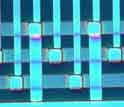|

Press Release 04-039
A Tiny Wind to Cool the Tiniest Circuits

Researchers develop miniature cooling system that generates nanoscale breezes
March 31, 2004
ARLINGTON, Va.—Researchers have crafted miniature cooling systems similar in concept to the silent fans now available to filter and circulate the air in homes, but the miniscule "fans" are only microns (millionths of a meter) across. Using minute voltages, the devices generate ions that discharge to create small breezes -- perfect for cooling cell phones, laptop computers, and the tiniest devices.
As electronics shrink, so must the cooling systems that keep them from overheating. The new technology developed at Purdue University is at the right scale for tiny electronic machines. The system's electrodes are crafted from carbon nanotubes only five nanometers (billionths of a meter) across at the tip, and the device does not use water or other cumbersome cooling fluids.
As power per chip shrinks, hotspots are confined to a smaller place and localized, says Richard Smith, a thermal systems expert and the National Science Foundation program officer who oversees some of the Purdue research team's funding. In this research, the total amount of energy to dissipate is not as important as the energy dispersed at such a fine scale.
The researchers behind this discovery include: Suresh Garimella, a professor of mechanical engineering at Purdue University, West Lafyette, Ind. and the NSF Compact High Performance Cooling Technologies Research Center (CTRC); Timothy Fisher, associate professor of mechanical engineering at the university; Daniel J. Schlitz , who recently earned a doctoral degree from Purdue; and doctoral student Vishal Singhal. Schlitz and Singhal were awarded business startup funds from Purdue to commercialize the cooling system.
What the researchers say:
"This device has the potential to make a cooling system that is an order of magnitude smaller than current technology." - Dan Schlitz
"The exciting attribute of this work is that it has the potential to provide heat removal rates that are similar to that of liquid cooling, but accomplishes this with air and in a very compact volume." - Suresh Garimella
NSF comments regarding the research discovery:
"Temperature control of sub-millimeter electronic systems is critical for a wide variety of advanced technologies that rely on computer chips and small-scale electronics." - Richard Smith
"Cooling with air, if successful, is an elegant solution because air is readily available and doesn't need to be stored, and unlike some other chemicals, air is part of our environment, not a potential contaminant." - Richard Smith
"Novel cooling techniques may prove essential for the next generation of laptop computers, cell phones, sensing systems, and many other types of portable microelectronics." - Richard Smith
-NSF-
For additional information, see the Purdue University release at:
http://news.uns.purdue.edu/UNS/html4ever/2004/040322.Garimella.nanolight.html
Compact High Performance Cooling Technologies Research Center (CTRC)
www.ecn.purdue.edu/CTRC

Media Contacts
Josh Chamot, NSF (703) 292-7730 jchamot@nsf.gov
Emil Venere, Purdue University (765) 494-4709 venere@purdue.edu
Program Contacts
Richard Smith, NSF (703) 292-8371 rnsmith@nsf.gov
Principal Investigators
Suresh Garimella, Purdue University (765) 494-5621 sureshg@ecn.purdue.edu

The National Science Foundation (NSF) is an independent federal agency that
supports fundamental research and education across all fields of science and
engineering, with an annual budget of $6.06 billion. NSF funds reach all 50
states through grants to over 1,900 universities and institutions. Each year,
NSF receives about 45,000 competitive requests for funding, and makes over
11,500 new funding awards. NSF also awards over $400 million in
professional and service contracts yearly.
 Get News Updates by Email Get News Updates by Email
Useful NSF Web Sites:
NSF Home Page: http://www.nsf.gov
NSF News: http://www.nsf.gov/news/
For the News Media: http://www.nsf.gov/news/newsroom.jsp
Science and Engineering Statistics: http://www.nsf.gov/statistics/
Awards Searches: http://www.nsf.gov/awardsearch/
| 



